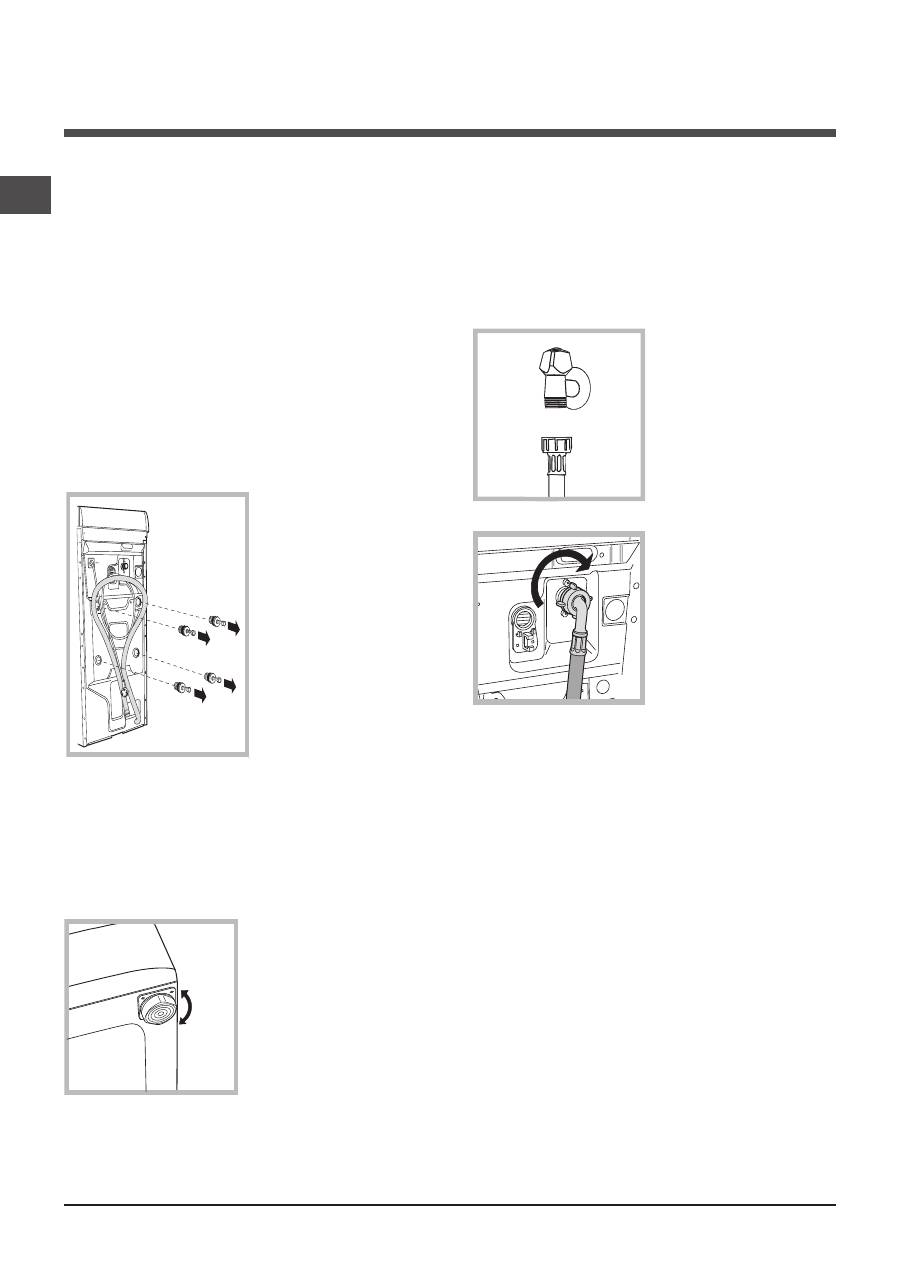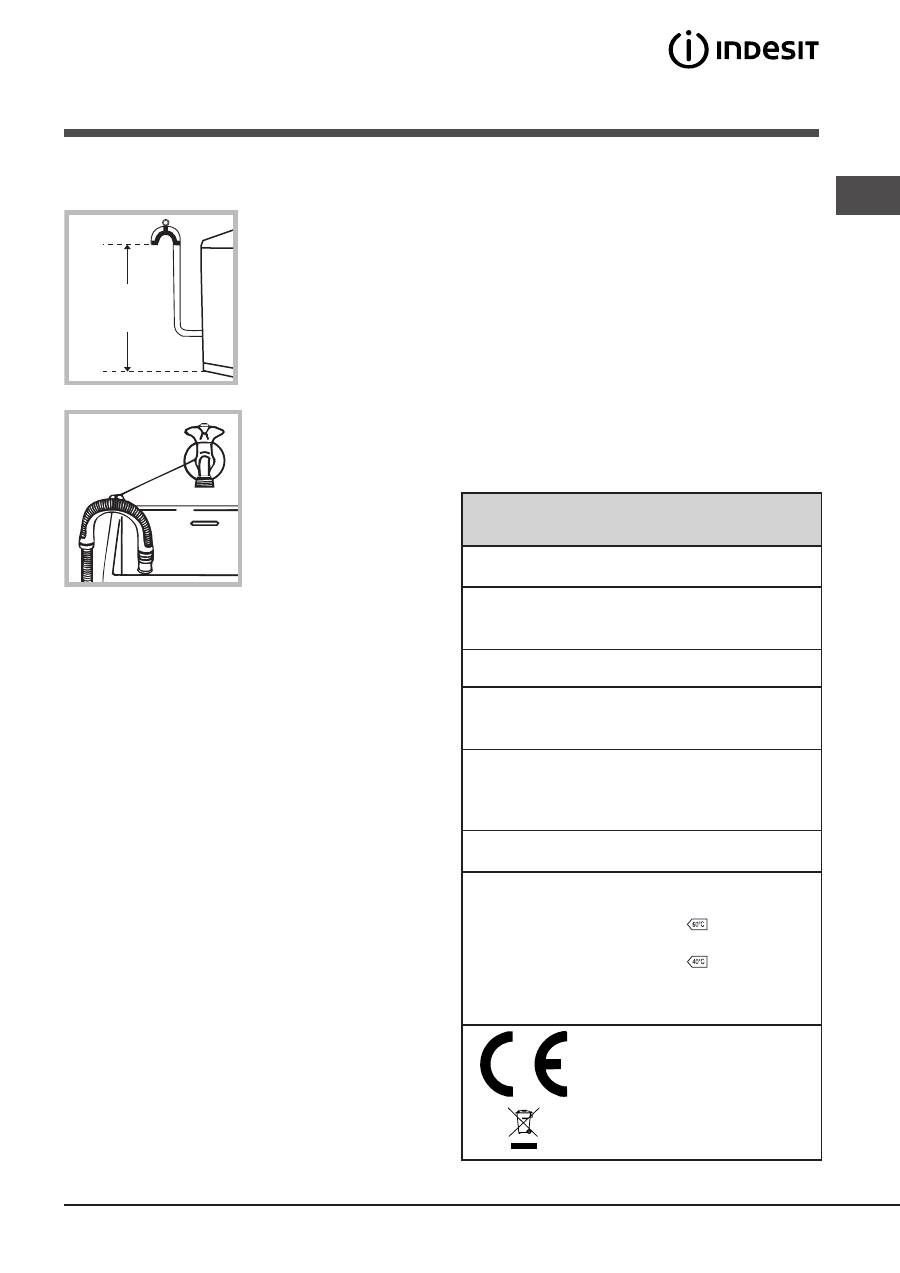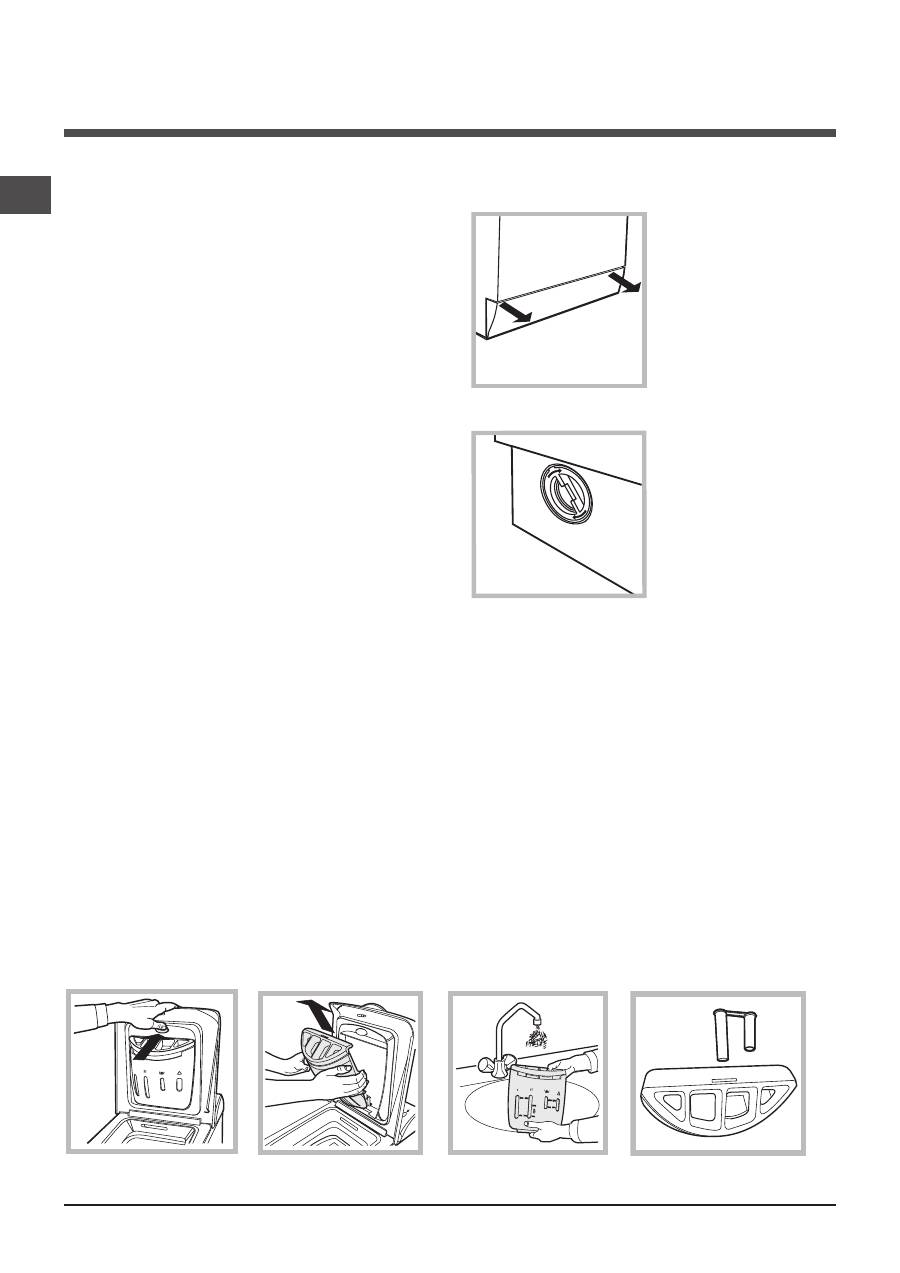Indesit WITXL-1051-(EU): instruction
Class: Household, kitchen appliances, electronics and equipment
Type: Laundry Machine
Manual for Indesit WITXL-1051-(EU)

1
GB
WASHING MACHINE
WITXL 1051
Instructions for use
Contents
Installation, 2-3
Unpacking and levelling
Electric and water connections
The first wash cycle
Technical details
Care and maintenance, 4
Cutting off the water or electricity supply
Cleaning your appliance
Caring for your appliance door and drum
Cleaning the pump
Checking the water inlet hose
Cleaning the detergent dispenser
Precautions and advice, 5
General safety
Disposal
Saving energy and respecting the environment
Washing machine description, 6-7
Control panel
How to open and shut the drum
Leds
Starting and Programmes, 8
Briefly: how to start a programme
Programme table
Personalisations, 9
Setting the temperature
Setting the spin cycle
Functions
Detergents and laundry, 10
Detergent dispenser
Bleach cycle
Preparing your laundry
Special items
Troubleshooting, 11
Service, 12
Before calling for Assistance
English, 1
GB
БЪЛГАРСКИ, 13
BG
GR
ΕΛΛΗΝΙΚΑ, 25
FR
UA
ES
Español, 37
Français, 49
Українська, 61
Русский,73
CIS

2
GB
Installation
!
Keep this instruction manual in a safe place for
future reference. Should the appliance be sold,
transferred or moved, make sure the instruction
manual accompanies the washing machine to
inform the new owner as to its operation and
features.
!
Read these instructions carefully: they contain
vital information on installation, use and safety.
Unpacking and levelling
Unpacking
1. Unpack the washing machine.
2. Check whether the washing machine has been
damaged during transport. If this is the case, do
not install it and contact your retailer.
3. Remove the four pro-
tective screws and the
rubber washer with the
respective spacer, si-
tuated on the rear of the
appliance
(see figure)
.
4. Seal the gaps using the
plastic plugs provided.
5. Keep all the parts: you
will need them again if
the washing machine
needs to be moved to
another location.
Warning: should the
screws be re-used,
make sure you fasten
the shorter ones at the top.
!
Packaging materials are not children’s toys.
Levelling
1. Install the washing machine on a flat sturdy
floor, without resting it up against walls, furniture
cabinets or other.
2. If the floor is not per-
fectly level, compensate
for any unevenness by
tightening or loosening
the adjustable front feet
(see figure)
; the angle
of inclination, measu-
red according to the
worktop, must not ex-
ceed 2°.
Levelling your appliance
correctly will provide it with stability and avoid any
vibrations, noise and shifting during operation.
If it is placed on a fitted or loose carpet, adjust
the feet in such a way as to allow enough room
for ventilation beneath the washing machine.
Electric and water connections
Connecting the water inlet hose
1. Connect the supply
pipe by screwing it to
a cold water tab using
a ¾ gas threaded con-
nection
(see figure).
Before performing the
connection, allow the
water to run freely until
it is perfectly clear.
2. Connect the other
end of the water inlet
hose to the washing
machine,
screwing it onto the ap-
pliance’s cold water in-
let, situated on the top
right-hand side on the
rear of the appliance
(see figure)
.
3. Make sure there are no kinks or bends in the
hose.
!
The water pressure at the tap must be within
the values indicated in the Technical details
table
(on the next page)
.
!
If the water inlet hose is not long enough,
contact a specialist store or an authorised
serviceman.
!
Never use hoses that have already been used.

3
GB
Technical details
Model
WITXL 1051
Dimensions
40 cm wide
85 cm high
60 cm deep
Capacity
from 1 to 6 kg
Electric
connections
Please refer to the technical
data plate fixed to the ma-
chine.
Water
connections
maximum pressure 1 MPa
(10 bar) minimum pressure
0.05 MPa (0.5 bar) drum
capacity 42 litres
Spin speed
up to 1000 rpm
Test wash
cycles in
accordan-
ce with
directives
1061/2010
and
1015/2010.
Programme
: Cotton stan-
dard 60°C;
Programme
: Cotton stan-
dard 40°C.
This appliance is compliant
with the following European
Community Directives:
- 2004/108/CE (Electroma-
gnetic Compatibility)
- 2006/95/CE (Low Voltage)
- 2012/19/EU
Connecting the drain hose
Connect the drain
hose, without bending
it, to a drainage duct
or a wall drain located
at a height between
65 and 100 cm from
the floor;
alternatively, rest it on
the side of a washba-
sin or bathtub, faste-
ning the duct sup-
plied to the tap (
see
figure
). The free end
of the hose should
not be underwater.
!
We advise against the use of hose extensions;
if it is absolutely necessary, the extension must
have the same diameter as the original hose and
must not exceed 150 cm in length.
Electrical connections
Before plugging the appliance into the electricity
socket, make sure that:
• the socket is earthed and complies with all
applicable laws;
• the socket is able to withstand the maximum
power load of the appliance as indicated in the
Technical data table
(see opposite);
• the power supply voltage falls within the va-
lues indicated in the Technical data table
(see
opposite);
• the socket is compatible with the plug of the
washing machine. If this is not the case, repla-
ce the socket or the plug.
!
The washing machine must not be installed
outdoors, even in covered areas. It is extremely
dangerous to leave the appliance exposed to
rain, storms and other weather conditions.
!
When the washing machine has been installed,
the electricity socket must be within easy reach.
!
Do not use extension cords or multiple sockets.
!
The cable should not be bent or compressed.
!
The power supply cable must only be replaced
by authorised technicians.
Warning! The company shall not be held respon-
sible in the event that these regulations are not
respected.
The first wash cycle
Once the appliance has been installed, and be-
fore you use it for the first time, run a wash cycle
with detergent and no laundry, setting the 90°C
programme without a pre-wash cycle.
65 - 100 cm

4
GB
To access the pre-chamber:
1. using a screwdriver,
remove the cover pa-
nel on the lower front
part of the washing
machine (
see figure
)
;
2. unscrew the lid by
rotating it anti-clockwi-
se (
see
figure
)
:
a little
water may trickle out.
This is perfectly nor-
mal;
3. clean the inside tho-
roughly;
4. screw the lid back
on;
5. reposition the panel,
making sure the hooks
are securely in place
before you push it onto
the appliance.
Checking the water inlet hose
Check the inlet hose at least once a year. If there
are any cracks, it should be replaced immedia-
tely: during the wash cycles, water pressure is
very strong and a cracked hose could easily
split open.
!
Never use second-hand hoses.
Care and maintenance
Cutting off the water and electricity supplies
• Turn off the water tap after every wash cycle.
This will limit wear on the hydraulic system in-
side the washing machine and help to prevent
leaks.
• Unplug the washing machine when cleaning it
and during all maintenance work.
Cleaning the washing machine
The outer parts and rubber components of the
appliance can be cleaned using a soft cloth
soaked in lukewarm soapy water. Do not use
solvents or abrasives.
Caring for the door and drum of your appliance
• Always leave the porthole door ajar in order to
prevent unpleasant odours from forming.
Cleaning the pump
The washing machine is fitted with a self-cleaning
pump which does not require any maintenance.
Sometimes, small items (such as coins or buttons)
may fall into the pre-chamber which protects the
pump, situated in its bottom part.
!
Make sure the wash cycle has finished and
unplug the appliance.
How to clean the detergent dispenser
Fig. 1
Fig. 2
Cleaning:
Then clean the dispenser under a tap
(fig. 3)
using an old toothbrush and, once the pair of
siphons inserted in the top of compartments
1 and 2
(fig. 4)
have been pulled out, check
whether the same are not clogged and then
rinse them.
Reassembly:
Do not forget to rein-
sert the pair of siphons
into the special housings
and then to replace the
dispenser into its seat,
clicking it into place
(fig.
4, 2 and 1)
.
Disassembly:
Press lightly on the
large button on the
front of the detergent
dispenser and pull it
upwards
(fig. 1)
.
Fig. 3
Fig. 4
Table of contents
- Installation
- Care and maintenance
- Precautions and advice
- Washing machine description
- Starting and Programmes
- Personalisations
- Detergents and laundry
- Troubleshooting
- Service
- Инструкции за ползване
- Монтиране
- Поддръжка и почистване
- Мерки за безопасност и препоръки
- Описание на пералната машина
- Включване и програми
- Програмиране според потребностите
- Перилни препарати и тъкани
- Проблеми и мерки за отстраняването им
- Сервизно обслужване
- Οδηγίες χρήσης
- Εγκατάσταση
- Συντήρηση και φροντίδα
- Προφυλάξεις και συμβουλές
- Περιγραφή του πλυντηρίου
- Εκκίνηση και Προγράμματα
- Προσωπικές Ρυθμίσεις
- Απορρυπαντικά και ρούχα
- Προβλήματα και λύσεις
- Τεχνική Υποστήριξη
- Instrucciones para el uso
- Instalación
- Mantenimiento y cuidados
- Precauciones y consejos
- Descripción de la lavadora
- Puesta en marcha y Programas
- Personalizaciones
- Detergentes y ropa
- Anomalías y soluciones
- Asistencia
- Mode d’emploi
- Installation
- Entretien et soin
- Précautions et conseils
- Description du lave-linge
- Mise en marche et Programmes
- Personnalisations
- Produits lessiviels et linge
- Anomalies et remèdes
- Assistance
- Довідник користувача
- Установлення
- Опис пральної машини
- Пуск машини і програми
- Налаштування пiд власнi потреби
- Пральні засоби і білизна
- Запобіжні заходи тапоради
- Догляд та очищення
- Несправності та засоби їх усунення
- Допомога
- Руководство по экпуатации
- Установка
- Описание стиральной машины
- Запуск машины. Программы
- Персонализация стирки
- Моющие средства и белье
- Предупреждения и рекомендации
- Обслуживание и уход
- Устранение неисправностей
- Сервисное обслуживание

